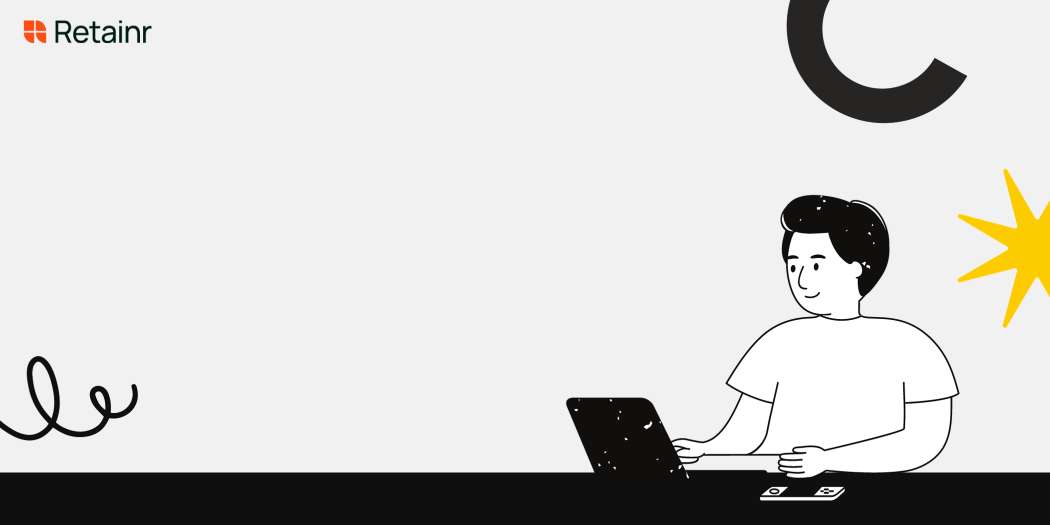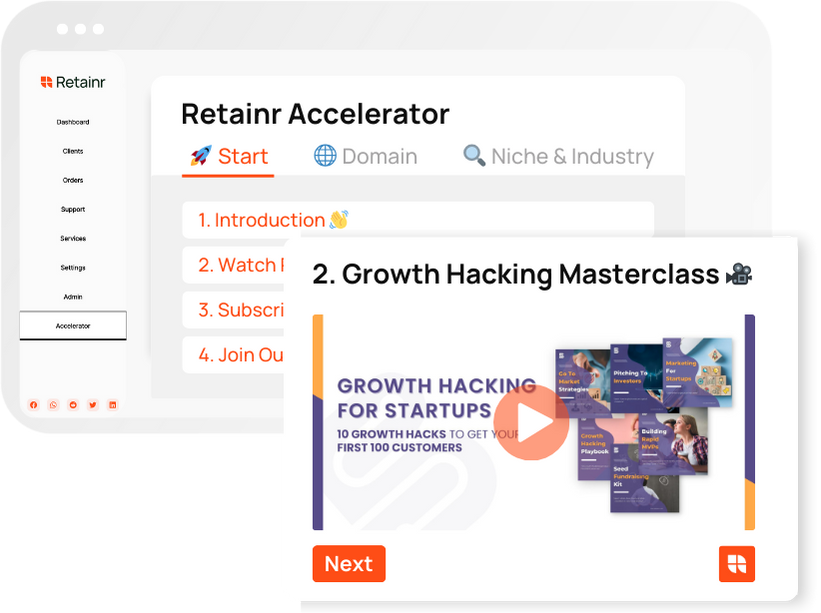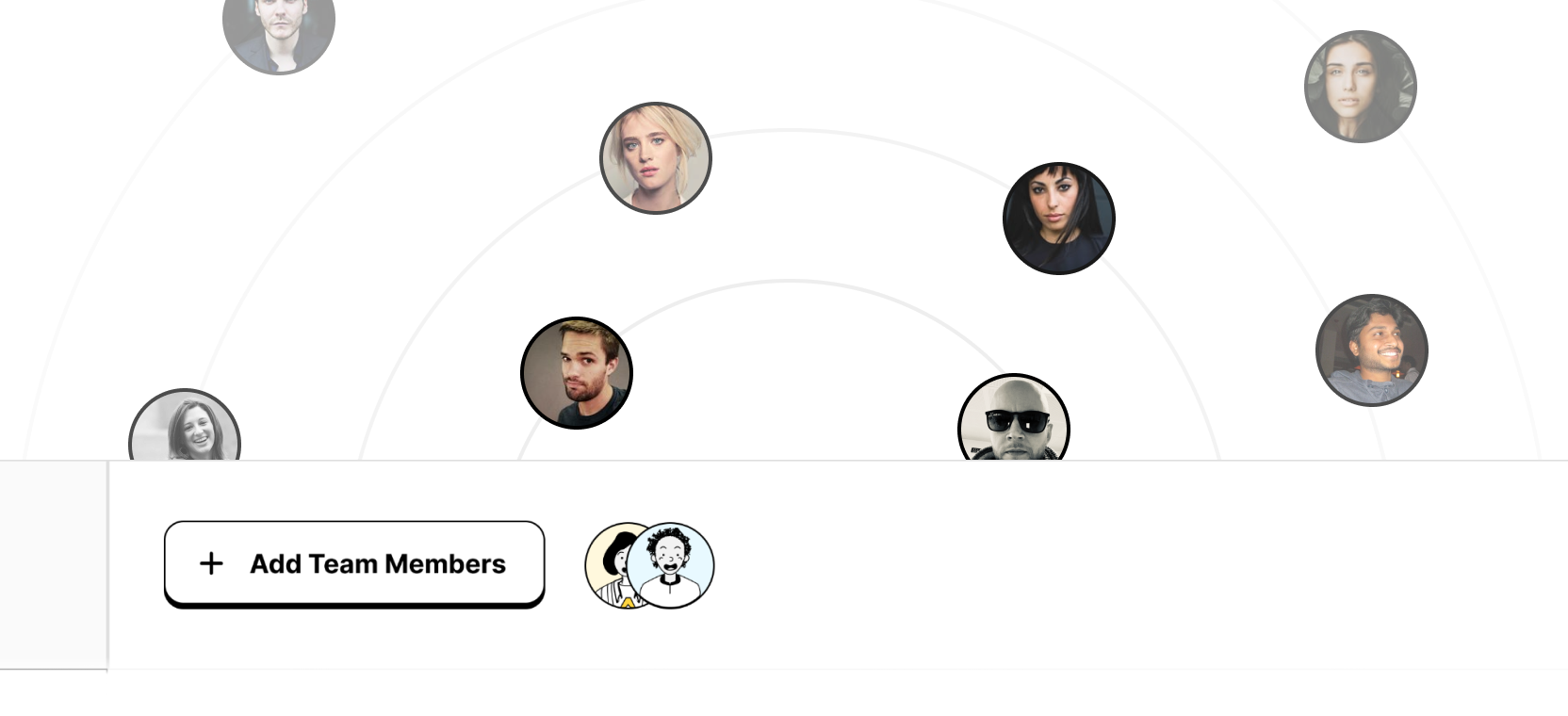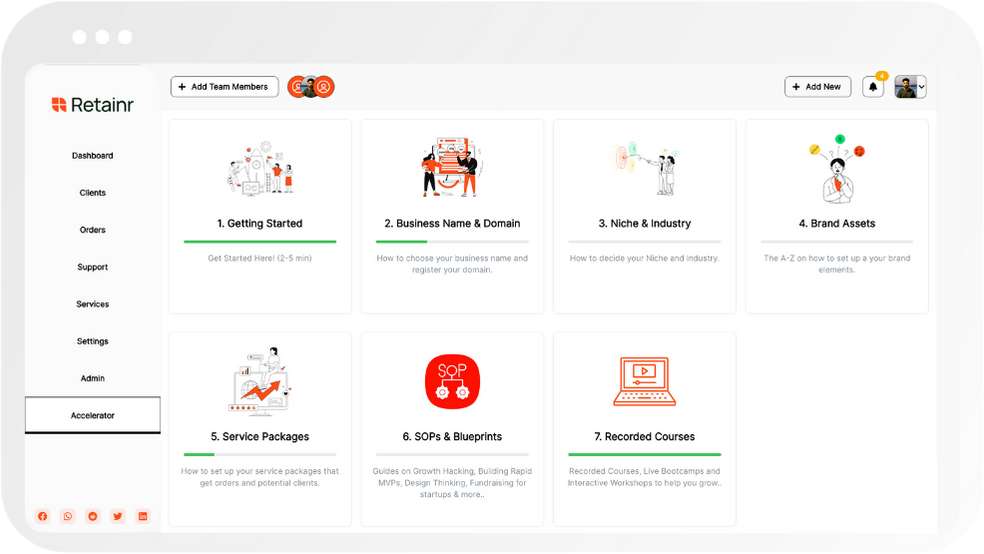
8 Tips and Tricks for Successful Social Media Management in Agencies
Build with Retainr
Sell your products and services, manage clients, orders, payments, automate your client onboarding and management with your own branded web application.
Get Started1. What are some tips and tricks for successful social media management in agencies?
Effective Strategies for Social Media Management
Successful social media management in agencies deftly blends creativity with strategic planning. Here are three primary tips to achieve this:
- Set Clear Goals: First and foremost, set defined, achievable goals. Whether it's increasing brand awareness, boosting website traffic or generating new leads. Clear objectives provide a framework to gauge your efforts and track your progress.
- Target the Right Audience: Understanding your target demographic is essential. This includes their interests, challenges, preferred social platforms, and online behavior. This knowledge will aid in crafting relevant messages that foster engagement.
- Monitor and Adapt: Social media is dynamic. Constant monitoring allows you to understand what works and what doesn't. Be ready to tweak your strategy based on your observations and industry trends.
Handy Tricks for Successful Social Media Management
Apart from the basics, here are some extra tricks that can help agencies outshine their competition on social media platforms:
- Using Visuals: Original, compelling visuals drive engagement. Utilize professional images, infographics, or short videos to capture your audience's attention.
- Employee Advocacy: Encourage your employees to share and engage with your brand's content. It's a great way to expand your reach organically.
- Scheduling Posts: Using social media tools to schedule posts at strategic times can increase visibility and engagement. Monitor your metrics to identify when your audience is most active.
Top Social Media Platforms for Agency Success
| Platform | Benefits |
|---|---|
| Offers advanced targeting options, large user base, and diverse content formats. | |
| High engagement rate, ideal for visual content, and popular among younger demographics. | |
| Best platform for B2B marketing, professional networking and showcasing thought leadership content. | |
| Great for real-time interactions, news updates, and customer feedback. |
2. How can social media be effectively managed in an agency setting?
Develop A Strategy
In an agency setting, successful social media management begins with a well-developed strategy. It's crucial to identify the target audience, establish goals, and determine the type of content that will be shared. Agencies must also decide on the frequency of publishing, appropriate social media platforms for their audience, and who will be responsible for content generation. Tracking and analyzing performance metrics is another must to adjust the strategy accordingly.
- Identify the target audience: An understanding of the demographics and behaviors of the intended audience is crucial. This information will guide the creation of effective content.
- Create a content calendar: Consistency is key in social media engagement. A calendar detailing when and what to post can ensure consistency and varied content.
- Delegate responsibilities: Clear delegation of tasks such as content creation, posting, and responses to audience engagement streamlines the process and ensures efficiency.
- Monitor and adjust: Track metrics like engagement rate, follower growth, and website traffic originating from social media. These insights help the agency refine its strategy.
Utilize Tools for Efficiency
Social media management tools can greatly augment efficiency. They help in scheduling posts, tracking analytics, managing comments and messages, and more. Some popular tools include Buffer, Hootsuite, and Sprout Social. Relying on these tools can help save time and keep things organized.
| Tool | Use |
|---|---|
| Buffer | Schedule posts, track performance, and manage all your accounts in one place. |
| Hootsuite | Allows management of multiple networks, schedule posts, and measure ROI. |
| Sprout Social | Offers a range of features including publishing and analytics, engagement, and customer service tools. |
Emphasize on Training
Continuous training is a must for successful social media management. The fast-paced nature of social media means trends change rapidly and platforms continually introduce new tools and features. Agencies should prioritize regular training sessions to ensure team members are abreast of current best practices and tools.
- Platform Use: Ensure your team understands how to use each platform effectively. This includes understanding the nuances of each platform's algorithm, the best times to post, effective content strategies for each platform, etc.
- New Features: Social media platforms frequently roll out new features. Encourage team members to stay updated and experiment with them to stay ahead.
- Performance Metrics: Team members should understand how to interpret performance metrics accurately and make data-driven decisions.
3. What tools are recommended for efficient social media management in agencies?
Recommended Tools for Efficient Social Media Management
Efficient social media management demands an array of advanced tools, empowering agencies to streamline operations, enhance productivity, and deliver superior results. Implementing such tools can revolutionize your scheduling, analytics, content creation, and engagement tasks. Here are our top picks:
- Buffer: An excellent platform that allows easy scheduling of posts across multiple social media accounts. Its analytics feature aids in tracking engagements and interactions.
- Sprout Social: Known for its comprehensive reporting system, Sprout Social also allows scheduling and provides a unified platform for all social media messages.
- Hootsuite: From scheduling posts to tracking conversations and campaign results, Hootsuite is a versatile tool for agencies.
- Canva: Ideal for content creation, Canva’s easy-to-use design features make it a great tool for creating engaging social media posts.
Detailed Comparison of Social Media Management Tools
Investing in the correct tools is essential, but understanding their key features helps make a wise decision. Let’s break down our chosen tools in detail:
| Tool | Scheduling | Analytics | Content Creation | Messaging Feature |
|---|---|---|---|---|
| Buffer | Yes | Yes | No | No |
| Sprout Social | Yes | Yes | No | Yes |
| Hootsuite | Yes | Yes | No | Yes |
| Canva | No | No | Yes | No |
The Choice Depends On Your Needs
In the end, choosing the right tool depends on your agency's specific needs. If your focus is on scheduling and analytics, Buffer, Sprout Social, and Hootsuite offer great solutions. However, if content creation is paramount, Canva is your best bet. Understanding what your agency needs will guide you to the right social media management tool.
4. How can an agency improve engagement on its social media platforms?
Understanding The Audience
One of the primary steps in improving social media engagement is understanding who the agency's audience is. This can essentially be achieved by doing some market research and identifying which social media platforms the audience is mainly active on.
- Perform demographic research to identify the age group, gender, interests, and other important information about the audience.
- Use social listening tools to keep track of what the audience is saying about the agency and its services. This enables getting useful insights into what the audience likes and their general sentiment about the agency.
- Analyze the performance of past posts to identify what type of content generates the most engagement.
Creating Engaging Content
Once the agency has an understanding of its audience, the next step is to create engaging content. The content must be relevant to the audience and must resonate with them. This could range from informative blog posts, interesting infographics or visuals, to timely and relevant updates or announcements that the audience finds useful.
| Types of Content | Engagement Characteristics |
|---|---|
| Blog posts | Can generate high engagement through comments and shares if the topic is interesting and relevant to the audience. |
| Infographics | Visually appealing and easily digestible content that often generates high levels of likes and shares. |
| Updates and Announcements | Promotes interaction if the information is timely and pertinent to the audience’s interest. |
Interacting With the Audience
One of the best ways to boost engagement on social media platforms is to actively interact with the audience. This isn’t restricted to just responding to comments on posts, but also involves proactive engagement strategies.
- Reach out to followers through polls, quizzes, and questions. Make it a two-way communication.
- Respond promptly to comments and queries. Show the audience that the agency values their feedback.
- Create hashtags or contests to promote user-generated content. This encourages audience involvement and increases overall engagement.
5. Are there any tips for creating more engaging content for agency social media?
Tips for Creating More Engaging Content
Engagement is the key to enhance your social media presence. Creating interesting and relevant content can increase interaction and engagement on your social media platforms. Here are some proven tactics:
- Know Your Audience: Understanding your target group's interests, their online behavior, and the type of content they engage with can aid in creating impactful content.
- Use Visuals: Incorporating visuals like images, infographics, videos, etc., increases user engagement. They can convey complex information in an easy-to-understand manner.
- Interactive Content: Surveys, quizzes, or live Q&A sessions enable direct interaction with your audience encouraging engagement.
- Use Hashtags: Proper use of hashtags can enhance your content's visibility and reach, leading to increased engagement.
- Storytelling: Narrating a story through your content about your brand, product, or customer experiences can engage the audience and build brand loyalty.
Use Of Tables And Other Visual Data
Incorporating tables or other forms of data visualization into your social media strategy helps to present information in an easily digestible way. A well-structured table can convey complicated data succinctly and clearly.
| Type Of Content | Purpose | Expected Engagement |
|---|---|---|
| Infographics | To explain complex information visually | High |
| Video Content | To capture attention and keep users engaged | Very High |
| User-generated Content | To build trust and authenticity | Medium to High |
| Data Visualization | To present data in a clear and concise manner | Medium |
6. What strategies can be utilized for successful social media management in the digital marketing industry?
Strategic Planning is Key
Successful social media management starts with strategic planning. This should include defining your target audience to tailor your posts and advertisements effectively. You need to also decide the social media platforms that best suit your target audience. Additionally, scheduling regular posts and engaging with your audience regularly is crucial.
- Define Your Target Audience: Understanding their demographics, preferences, and online behaviors.
- Social Media Platforms: Focus on platforms where your target audience is most active.
- Schedule Regular Posts: Robot posting - with human-like timing, avoids spamming and makes sure your audience receives regular content.
- Audience Engagement: Reacting to comments, likes, shares, and more increases your brand's visibility and engagement.
Content Creation and Optimization
Next, content creation and optimization plays a significant role in social media management. This includes creating eye-catching visuals, informative videos, engaging text, and more. Using search engine optimization (SEO) based keywords in your posts can enhance visibility. Lastly, make sure your content aligns with your brand identity.
| Content Type | Role in Social Media |
|---|---|
| Visuals | Captures audience attention instantly |
| Videos | Most engaging form of content |
| SEO based text | Increases content visibility on online platforms |
| Brand-Aligned Content | Maintains consistency and promotes brand recognition |
Focus on Analytics
Finally, the importance of analytics in social media management cannot be overlooked. It is vital to track and analyze your performance regularly. This could include monitoring likes, shares, comments, and overall audience engagement. Furthermore, understanding the best times to post, which posts are most successful, and where your traffic comes from is a major part of refining your strategy. Tracking these metrics ensures consistent improvement in your social media campaigns.
- Monitor Engagement: Track likes, comments, shares, and more to understand your audience's preferences.
- Best Times to Post: Monitor user activity to decide the optimal times for posting.
- Successful Posts: Understand which posts are most popular and replicate their success.
- Traffic Sources: Knowing where your traffic comes from can help tailor your strategy effectively.
7. How can agencies effectively manage multiple social media accounts?
Utilizing Effective Tools
The first step to managing multiple social media accounts for agencies is to utilize effective tools. This includes social media management platforms such as Hootsuite, Buffer, or SocialPilot. These tools allow you to schedule posts in advance, monitor various metrics, and manage all your social media profiles from one place. For example:
- Hootsuite: Allows monitoring of multiple streams from one dashboard, publishes directly to social channels, and offers team collaboration features.
- Buffer: Has a user-friendly interface, can schedule content across multiple channels, and analyzes social media performance.
- SocialPilot: Provides bulk scheduling, client management, and social media analytics.
Setting Up Strategies and Planning Ahead
In order to effectively manage multiple social media accounts, agencies need to set up strategies and plan ahead. A content calendar can be crucial in organizing upcoming posts, campaigns, and promos. Furthermore, to maximize efficiency and maintain consistency, batching content creation can be helpful. This involves creating a bunch of content in one sitting and scheduling it out over time. Key elements in social media strategy include:
| Element | Description |
|---|---|
| Goals | Identifying what you want to achieve through social media management. |
| Audience | Knowing your target audience and creating content that appeals to them. |
| Scheduling | Organizing when and where each piece of content will be published. |
Delegating Tasks and Communication
With multiple social media accounts to manage, task delegation and clear communication become paramount in agencies. Roles should be clearly defined whether it's creating content, scheduling posts, responding to comments, or analyzing metrics. Team members should also be conscious of how they communicate about tasks and progress - consider using project management tools such as Asana, Slack or Trello. Here are some suggested roles within a social media team:
- Content Creator: Develops engaging content aligned with brand voice and values.
- Social Media Manager: Schedules posts, monitors engagement, and evaluates metric performance.
- Community Manager: Responds to comments, builds community relations, and handles crisis management.
8. How often should an agency post content on their social media platforms for maximum effectiveness?
Understanding the Ideal Posting Frequency
Discovering the sweet spot for content posting can greatly boost the effectiveness of an agency's social media efforts. However, remember that there is no definitive answer; the frequency may differ depending on the agency's audience and the specific social media platform. Here are some general guidelines:
- Facebook: 1-2 posts per day
- Instagram: 1-3 posts per day
- Twitter: 3-30 tweets per day (Including retweets)
- LinkedIn: 1 post per day
Customization According to Audience Engagement
The crucial aspect to consider here is the audience engagement, which can necessitate adjustments in the quantity of posts. Social media management tools can provide analytics to track and measure the reach and engagement of posts. By using these metrics, agencies can determine the best times and frequencies for their posts to best engage their audience.
| Metrics | Use |
|---|---|
| Reach | Number of people who have seen a post |
| Engagement | Number of interactions such as likes, comments, and shares a post has received |
| Impressions | Number of times a post has been seen |
Adapting to Algorithm Changes
Over time, social media platforms modify their content visibility algorithms, potentially impacting your social media strategy. Staying updated and adapting to these changes is key for maximum effectiveness. For instance, Instagram now prioritizes “recency” in their algorithm which may dictate more frequent posts, while Facebook may penalize brands that appear too 'spammy,' thus warranting a more cautious approach.
9. What is the importance of analytics in social media management for agencies?
The Central Role of Analytics in Social Media Management
Social media analytics is considered an essential part of social media management for agencies for a variety of reasons. Analytics give insights into user behavior and response, which can guide agencies in shaping their social media strategy. They enable an agency to understand what content resonates most with their audience, the prime times for posting, and the overall impact of their social media efforts.
Key Benefits of Social Media Analytics
- Performance measurement: Analytics provides quantifiable measures of success or failure, allowing agencies to evaluate their social media endeavours on metrics like engagement rate, click-through rate, and follower growth.
- Target audience identification: Through analytics, agencies can identify demographic information of their audience and tailor content accordingly. This reduces wastage of resources and improves conversion rates.
- Competitive analysis: Social media analytics helps track competitors' activities, offering insights into their strategies and tactics and highlighting areas for improvement.
- Content optimization: By understanding what types of content gain more engagement, agencies can create more of the same kind, leading to an enhanced user engagement.
The Metrics of Social Media Analytics
| Metrics | Description |
|---|---|
| Reach | Measures the number of unique views for a certain post or story. |
| Engagement | The number of interactions your content gets, such as likes, shares, and comments. |
| Follower growth | The rate at which your follower count is increasing. |
| Click-through rate | The percentage of users who click on the link provided in a post. |
With the above metrics and the insights drawn from them, it becomes clear that the role of analytics in social media management is indispensable for agencies seeking to maximize their online presence and effectiveness.
10. Can you give examples of how to deal with negative feedback or crisis on social media for agencies?
Handling Negative Feedback
When dealing with negative feedback on social media, it's crucial to remain calm and professional. Here are a few steps that can help:
- Plan Ahead: Always have a strategy in place for when you receive negative comments or feedback. It can be very helpful having a pre-approved list of responses and a set protocol.
- React Promptly and Professionally: The sooner feedback is acknowledged the better. Respond professionally, thanking them for their feedback and promising to look into the matter can be a good starting point.
- Engage Privately: If things heat up, consider taking the conversation offline or to a private chat to handle.
Managing Social Media Crisis
A social media crisis can escalate quickly if not managed properly. Thus, agencies have to be prepared:
- Monitor: Keep an eye on your social media channels, understand what's happening, how it started, and who is driving it.
- Respond Quickly: The quicker you respond, the faster you're likely to get ahead of the situation.
- Pause Posting: It can be seen as insensitive or ignorant to continue schedule posting during a crisis, so consider putting your regular posts on hold.
Example Scenarios and Actions
We can learn a lot from real-life examples and how they were addressed:
| Scenario | Action |
|---|---|
| Negative product review | Thank the reviewer for their feedback, assure them that their issue is being looked into, and offer to continue the conversation offline. |
| Crisis involving negative media attention | Address the issue immediately on the same platform it arose, clarify any misconceptions, and assure followers steps will be to taken to resolve the issue. |
Conclusion
Achieve Success in Social Media Management with these 8 Tips
Effective social media management is essential for every agency seeking to engage audiences, build brand recognition and boost its client's digital visibility. This blog post highlights 8 vital tips and tricks to help make social media management a successful venture for any agency.
1. Understand your Client's Needs
Before implementing any strategy, it's crucial to understand your client's needs, objectives and target audience. Explicit communication can go a long way in achieving targeted outcomes.
2. Have a Comprehensive Content Strategy
A well-planned content strategy, including audience-specific content and regular updates, is important for online engagement. Ensure you're providing value and promoting interaction.
3. Use the Right Tools
Using effective tools and applications make social media management seamless and efficient, be it for scheduling posts or evaluating performance metrics. Retainr.io is a whitelabel software designed to manage clients, orders, and payments with ease, and it also offers your own branded app.
4. Focus on Engagement
Engaging content is key; responding promptly to queries and comments fosters a positive brand image.
5. Be Consistent
Consistency across all social media platforms is key for maintaining a cohesive brand image and message.
6. Analyse, Learn and Adapt
Regular analysis of social media performance can help you understand what works for your audience. Learns from trends and adapt strategies accordingly.
7. Utilise Influencer Collaborations
Influencer marketing can help enhance reach and create buzz around your client's brand. Choose influencers that align well with your client's image and value proposition.
8. Keep Up with Platform Updates
Social media platforms frequently update their algorithms and interface. Keeping up-to-date allows for optimal utilisation of these platforms.
In summary, effective social media management requires a thorough understanding of client needs, a comprehensive content strategy and the right tools. We recommend Retainr.io to simplify the management process and enhance productivity of your team.
Boost Your Agency Growth
with Retainr Accelerator
Uncover secrets, strategies, and exclusive blueprints to take your agency's growth to the next level — from marketing insights to effective presentations and leveraging technology.

SOPs, Cheatsheets & Blueprints
Leverage 50+ SOPs (valued over $10K) offering practical guides, scripts, tools, hacks, templates, and cheat sheets to fast-track your startup's growth.
Connect with fellow entrepreneurs, share experiences, and get expert insights within our exclusive Facebook community.
.jpg)

Join a thriving community of growth hackers. Network, collaborate, and learn from like-minded entrepreneurs on a lifelong journey to success.

Gain expertise with recorded Courses, Live Bootcamps and interactive Workshops on topics like growth hacking, copywriting, no-code funnel building, performance marketing and more, taught by seasoned coaches & industry experts.

.jpg)

.jpeg)


